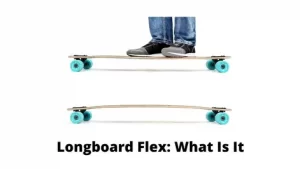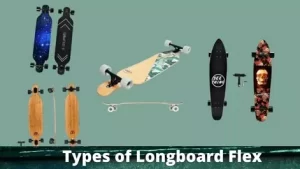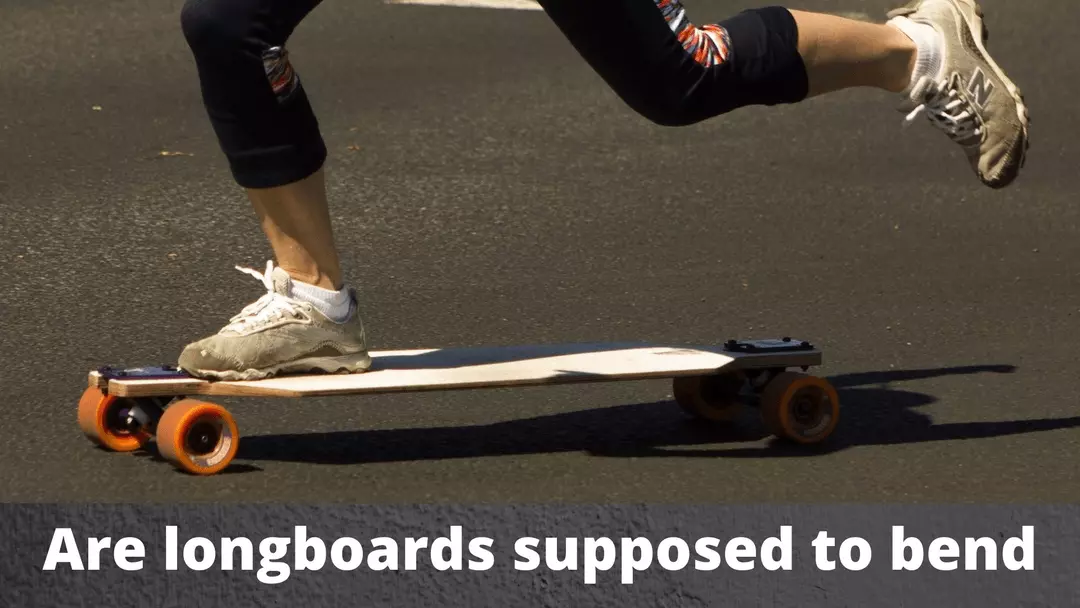Yes, longboards tend to bend to remain stable and balanced and offer better control. Longboards are specially designed for long rides and curves at higher speeds. And that stability and balance are required for speedy travel.
Longboard Flex: What Is It?

The rigidity of a longboard deck determines its bend, which controls the shock absorbency and flexibility of the longboard. A longboard can bend in three directions, including longitudinal, lateral, and torsional.
A particular type of bend happens depending on the riding style, which then influences the ride. Thus, it’s essential to consider the turn of the longboard while buying a new one.
Why Do Longboards Flex?
Longboards are prone to bend and flex, which can happen for many reasons, and control the whole riding experience. The longboard bend keeps the longboard stable and ensures improved control while carving and crushing on rough surfaces.
This feature also makes it different from other typical types of skateboards. Many people don’t know why it’s mainly designed to offer comfortable long rides.
Different bends happen for various reasons to offer a comfortable riding experience. The angle makes the carving and cruising smoother and offers a bouncy feel while riding the board. This way, the longboard bend provides a significant push to the ride.
Despite that, it offers total control to the rider over the longboards during cruising and carving over various surfaces. Every type of longboard is supposed to bend to keep the rider’s body in good balance.
The longboard comes in three different types so that the rider can get a comfortable ride based on their preferred style. The length of the longboard makes it faster, while its bend keeps it stable for safe rides. People mainly use longboards for racing downhill, traveling, and cruising.
Types of Longboard Flex

As you already know, longboard flex comes in three types. Let’s get some quick ideas on these types:
Longitudinal Flex
The longitudinal bend offers flexibility, and the deck flexes from the nose to the tail direction. It also digs into the middle of the board deck deeply. Professionals mostly give the flex rating according to this longitudinal flex.
Lateral Flex
This bend happened from the left side deck to the right side.
Torsional Flex
If the longboard causes longitudinal and lateral bends, it’s called “torsional flex.”
Level of Longboard Flex
The longboard can bend from a soft to a stiff level, which significantly impacts the riding experience. Flex and speeds are different terms.
A ridged and low-flex longboard is the ideal combo for high-speed riding. It keeps the longboard highly stable, essential for racing down the hill.
Conversely, soft flex is more beneficial for cruising around on a mellow ride as it prevents cracking or bumping on the sidewalk or pavement.
Along with the shape and style, the longboard has a certain level of flex. Sometimes you can opt for multiple options based on the flex. You understand the impact of flex limits on the possibilities of a longboard. Thus, knowing what flex means in a longboard ride is better.
Soft
Soft flex can absorb shock impressively while riding a longboard over rugged and uneven roads. But it does not keep the longboard stable, especially if ridden at medium to high speed. A soft-flex longboard is preferable for freestyle riding as it prevents feeling the jump.
However, sometimes a super soft board can make it harder to turn and do tricks, resulting in difficulty controlling the board.
Medium
This level of bend offers a bouncy feeling and adds extra energy to moving during riding. A medium level of flex also absorbs shock well on rough surfaces. Therefore, a longboard with medium flex is perfect for freeriding with some speed. It also offers higher stability at moderate rates.
Stiff
This stiff level of bend keeps the longboard highly stable even at high speed. It’s a perfect bend for free speedy riding and bombing hills. It’s also the right choice for downhill riding as it prevents wobbling even after passing the speed limit.
Let’s have a quick look at a different level of flex and their impact on riding along with preferred style:
| Level of flex | Impact on riding | Preferred style |
| Soft |
|
Cruising
Freestyle |
| Medium |
|
Free riding |
| Stiff |
|
Downhill |
The right level of flex should be in a longboard.
The amount of flex a longboard should have mainly depended on the user’s riding style. If you often ride at high speed, choose a longboard with a stiff level of the bend. This combo will offer maximum stability during fast riding.
But if you prefer freestyle riding, a longboard with a soft to medium flex level will be good enough for you. A longboard with a smooth flex level is also recommended for a rider who wants to cruise around.
Longboards come in different models and flex ratings, and you can pick a longboard with the right amount of flex based on your body weight.
Longboard flex chart
| Model name | Flex 1 | Flex 2 | Flex 3 | Flex 4 | Flex 5 |
| Dervish Sama | 170 – 270+ | 100 – 185+ | 75 – 150+ | ||
| Icarus | 170 – 270+ | 75 – 200+ | |||
| Tan Tien | 170 – 270+ | 130 – 210+ | 80 – 170+ | ||
| Fattail | 170 – 270+ | 125 – 215+ | 75 – 175+ | ||
| Vanguard | 175 – 230+ | 150 – 210+ | 150 – 200+ | 120 – 170+ | 80 – 140+ |
| Bhangra | 150 – 270+ | 90 – 190 |
Note: Flex ratings are given based on body weight, so a heavyweight gets a flex rating of 1, while a skinny person gets a lower rating. Plus, all the body weights are mentioned in lbs.
Is Longboard Stiff better than Flex?
Many riders try to avoid flexing their longboards when it comes to stability, but it isn’t always a good idea. A stiff longboard remains stable at high speed but isn’t the right choice for freestyle riding.
Flex offers some pushes and bounces, but a stiff board can’t do it. Regardless, A rigid longboard doesn’t absorb shock as well as flex on rugged and rough roads.
FAQs
#1. Should you use a flexible longboard?
Choosing a longboard with the right level of flex is vital. But it doesn’t mean you always have to go for a highly flexible longboard. If you want to ride at high speed, your longboard should have low flex as you require more stability.
#2. Can a longboard be flat?
If your area has no slopes, you can try flat land riding. Luckily, there are plenty of longboard models that you can use for flat riding.
#3. How fast do longboarders go?
You can ride your longboards at six mph while cruising. The speed reaches up to 50-65 mph during downhill riding. The speed of a longboard depends on the style of riding, the ability to push and pump the board, and the kind of slopes. The weight of the rider also controls the riding speed.
Final words
I hope now you know whether longboards are supposed to bend or not. Along with providing the reasons, we also discuss the type and level of flex, as these are essential things to consider for comfortable riding. So now, you should be able to pick the kind of longboard with the right level of flex based on your riding style, weight, and preferred surfaces.

